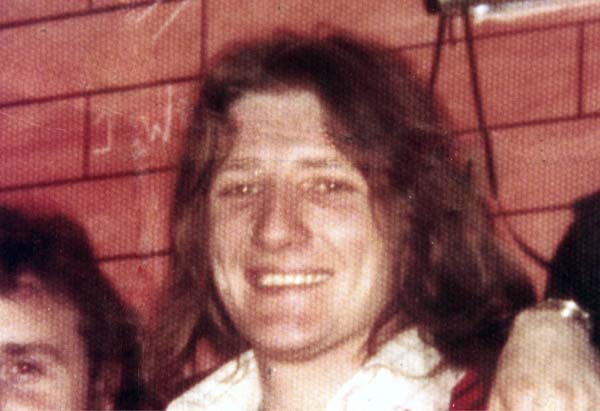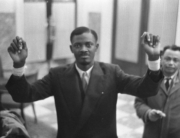Bobby Sands: 66 Days has two built-in audiences: cinephiles who are curious about the real story behind the hunger-striking Irish Republican Army militant rivetingly portrayed by Michael Fassbender in Steve McQueen’s Hunger (2008), and those with a personal interest in the three decades of the Irish Troubles, which were peacefully negotiated to a close in 1998. But the reason those outside the BBC Northern Ireland/BBC Storyville documentary’s audience should get past the thick Irish brogues and dense references to IRA and political factions is for a case study in terrorism. What can be learned from Bobby Sands’s tactics and the British response in dealing with today’s ideological, political, and religious extremists elsewhere in the world?
While the Troubles have been portrayed to Americans as a civil rights struggle by the Catholic minority to gain equality with the majority Protestants in Northern Ireland, none of the many childhood friends, political allies, and co-prisoners of Sands interviewed by director Brendan J. Byrne ever use those terms. They talk of violence, retaliation, and revolution—one is wearing a Palestinian keffiyeh scarf.
As the film counts down the 66 days of Sands’s hunger strike in Northern Ireland’s Maze Prison and his changing physical condition, it flashes back to significant stages in his biography, starting with a childhood marred by violent attacks in his neighborhood by Union Nationalist bullies and his mother’s evocations of the 1916 Easter Rising against British rule that led to the (uneasy) partition of Northern Ireland from the new Republic of Ireland in 1922.
Amid the constant barrage of TV images of demonstrations, buildings on fire, and heavily armed soldiers (which don’t seem to vary from year to year), historians helpfully provide more background than the eyewitnesses. They note the roots of the IRA’s hunger strike technique: Catholics inspired by Jesus’s example and a 19th-century Irish tradition of martyrdom (not that this is the only religion with this belief and fasting rituals).
For Sands, all the symbols came together under his growing leadership when the rounded-up Provisional IRA members (“Provos”) were placed together as “special category” prisoners, who in the early 1970s were not treated as the usual uniformed convicts. Several ex-prisoners remember how he encouraged them to read books by international revolutionaries and conducted “storytelling” sessions on revolutionary strategies. (In several recent documentaries, such as Disturbing the Peace, Palestinians recounted learning about nonviolent protest in Israeli prisons.)
The British authorities’ cancellation of political prisoner status in 1976 set off the “blanket protest” inside, with the inmates refusing uniforms and the use of lavatories, plus murderous retaliations against guards outside the prison. (A guard describes the horrible conditions resulting inside.) In 1980, several of the IRA prisoners began hunger strikes, but the IRA chose to negotiate to save the lives of those most far along and declared whatever concessions the British made were a sufficient victory.
But these negotiations were unsatisfactory to Sands, and he went ahead on a hunger strike a year later, with the strong support of other prisoners. Within a theatrical re-creation of his cell, Sands’s state of mind is revealed through his writings and diaries during the first 17 days of his hunger strike, which are made available by his family to the public for the first time. His extensive fond thoughts of birds and his mother (animated for the film) humanize him beyond the Che-like, long-haired, screen-printed image seen on posters and murals.
The external reactions are more revealing politically for the comparisons made to pro- and anti-terrorist strategies by different groups and governments today. Outside the prison, the decision is made to run Sands for Parliament while he’s on hunger strike, but enthusiasm for his candidacy is counteracted in public opinion by another IRA bombing. Throughout, the IRA decision-making hierarchy, and whether any of the interviewees had anything to do with either the violent or nonviolent protests, remains unclear.
The documentary seems to be on weaker ground in parsing Prime Minister Margaret Thatcher’s reactions and policies, even though her former aides are interviewed. There are also a couple of outright errors about the United States’ response: Mario Biaggi was in the House of Representatives, not the U.S. Senate, railing against the British in Congress; and Ronald Reagan’s tough advice to Thatcher wasn’t based generally on his management of California prisons as governor but specifically on his comparably aggressive handling of the Black Panthers.
The conclusion speeds ahead in crediting Sands and the nine other hunger strikers’ martyrdoms as leading directly to the peace agreement signed more than 15 years later, though they seem more like a messy, torturous step toward making that possible. Left alone is the irony that Brexit has raised talk of a referendum for unification between Northern Ireland and Ireland.
I just kept trying to figure out: How is Sands different from today’s Muslim militants? How is his martyrdom different from suicide bombers? Have the British and other Western countries learned from this experience? The answers are not simple and may be disturbing, but the larger context helps to make this very narrow, very detailed documentary more relevant today.







Leave A Comment